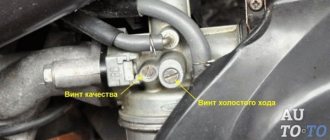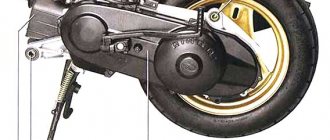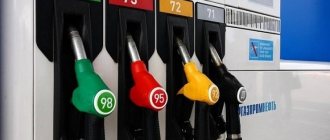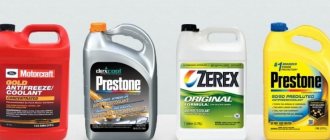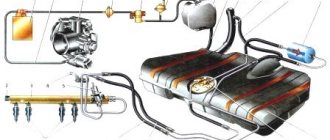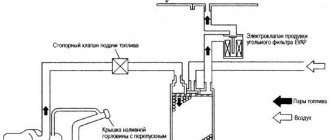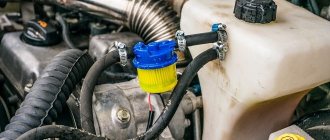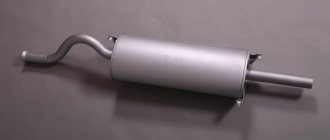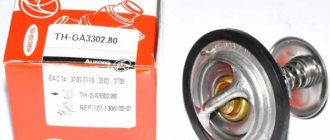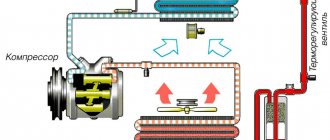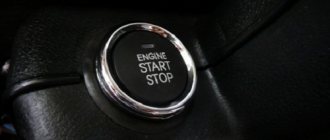Motorcycle carburetors take air and mix it with fuel. Numerous factors can cause a motorcycle carburetor to fail. As a rule, motorcycle carburetors are upset by vibration. Manufacturers such as Mikuni, Keihin and S&S sell original equipment and aftermarket carburetors for numerous motorcycles. The details vary, but the setup principles are the same for all of these devices. Here, in particular, is how to adjust the carburetor that Harley-Davidson has used since 1989.
Mix but do not shake. Intake system
Part 1. Fuel system. Carburetor and electronic injection In previous articles, we figured out what the engine of a modern production motorcycle is. However, a bike is a complex system of devices that interact seamlessly with each other, and you can’t go far with just one engine. Therefore, for normal operation, the engine needs additional systems: an intake system and an exhaust system. The first serves to precisely control the air-fuel mixture entering the cylinders, the second removes exhaust gases after combustion. But before we take a closer look at these systems, it’s worth first understanding what our two-wheeled friends “eat”.
Fuel As soon as the very first motorcycle appeared, its fuel tank was filled with the same liquid that is used to this day. Gasoline is a generally accepted fuel for motorcycles. Of course, there are many alternative fuels, but they are either more expensive or less efficient. Like many other decisions in the motor industry, choosing gasoline as a fuel is a compromise. In this case, between two properties: evaporation (volatility) and calorific value. The volatility of a fuel is a measure of how easily it will evaporate at low temperatures. Calorific value is the amount of thermal energy, and therefore useful work, that can be obtained from a given amount of fuel. You've probably already guessed that, ideally, an internal combustion engine needs a fuel that evaporates easily and has a high calorific value. However, as the calorific value increases, the volatility of the fuel decreases, and the lower volatility of the fuel makes it more difficult to ignite. So, we have chosen the fuel. Now you need to figure out in what ratio to mix it with air in order to obtain the most complete and efficient combustion. If there is not enough air, the unburned fuel will literally “fly out of the chimney”; if there is a lot of air, the useful energy received from the cylinder will decrease. To ensure complete combustion, 14.7 parts of air must be 1 part of fuel. Chemists call this ratio stoichiometric. To extract maximum power from the engine, the mixture is made “rich” (lack of air up to 10%), to achieve maximum efficiency - the mixture is “lean” (excess air up to 10%). In addition to atmospheric parameters, engine design and combustion characteristics also influence the optimal mixture composition. In reality, the limits for successful combustion of the mixture are between 12:1 and 18:1. The only thing left is to install on the bike a reliable system for supplying this very mixture to the combustion chambers.
Intake System Before moving on to the key players in the “intake command” - carburetors or fuel injection systems, let's understand the path the air-fuel mixture takes to get into them. The fuel tank begins the winding path of gasoline to the engine. It is supplied from the tank by gravity (in most modern motorcycles, except perhaps the simplest ones, the supply occurs under pressure using a fuel pump) through a filter along the fuel line to the carburetors or injector nozzles. To control the flow of fuel, a manually or automatically controlled fuel valve is used, which opens or shuts off the fuel supply from the tank. On most fuel injection systems, there is no valve as such, and the function of controlling fuel flow is performed by the fuel pump. We will talk about how air is mixed with gasoline in the next article, and at the same time we will discuss supercharging and turbocharging systems. Gradually, under the pressure of increasingly stringent environmental standards and requirements for engine performance, the carburetor is giving way to fuel injection systems. Even ease of setup and low cost of production are no longer its strong suits. Living confirmation of this is that small-capacity scooters from the same Honda , like the SH 150 , at their moderate price, are equipped with an injector. The same applies to cross-country motorcycles - in 2008, Suzuki were the first to install injection on their off-road machine RM-Z450 . Other Japanese manufacturers soon followed suit. Nowadays, the carburetor is used only where ease of maintenance and unpretentiousness in the choice of gasoline still plays a role: small-capacity bikes for beginners (Kawasaki Ninja 250R is still equipped with carburetors, however, only in the version for the US market) and single-cylinder enduros like the Honda XR650L . Streetfighters, classics, sportbikes and cruisers have made a massive transition over the past few years from carburetors to more technologically advanced and efficient electronic fuel injection systems. However, we will still consider carburetors - after all, there are enough motorcycles of various ages traveling on the roads all over the world (and not just the hot new products of recent years), so you shouldn’t write off “carburetors” from accounts. First, let's understand the basic principles of operation of any carburetor.
Suzuki RM-Z450 - the first motocross bike with fuel injection system
The principle of operation of a carburetor The principle of operation of any type of carburetor is based on the atomizing effect of the diffuser. It is a specially shaped tube. Imagine - if air flows through an ordinary pipe with parallel walls, then the pressure and speed of air movement will be constant throughout the entire length of the pipe. If you make a narrowing in the pipe, the air flow characteristics will change: at the narrowing point, the air flow speed will increase and the pressure will drop. Thus, a vacuum is created at the point of greatest narrowing. In the minimum cross-section of the diffuser there is a hole through which the fuel enters the diffuser and, under the influence of the spraying effect, breaks up into tiny droplets. In the hole there is a jet (nozzle) of such a size that each part of the incoming fuel will correspond to 14 parts of air. That's all, the simplest carburetor is ready. It will cope with providing the engine with a fuel mixture at constant loads and at the same crankshaft speed. However, such engine operation is a utopia, and therefore we will need a more complex device. To ensure uninterrupted operation, the carburetor requires a constant supply of fuel, the level of which at a constant level is ensured by a float mechanism in float chamber . The principle of its operation is very simple, but it is better to see it once than to read my writings here. Therefore, I suggest you, dear readers, to go to... the toilet. However, not for the reason we usually go there, but in order to remove the lid from the toilet cistern. Before your eyes you will see the carburetor float mechanism, enlarged many times. If you flush water into the toilet, its level in the tank will drop, the float will drop and open the valve, through which the water will again enter the “toilet float chamber”. Everything is extremely simple. To control engine speed, you need to use some kind of device that will limit the amount of air-fuel mixture entering the engine. A round plate mounted in a diffuser on a moving axis can be used as such a device. By adjusting the opening angle of this plate, called the throttle valve , we control the amount of mixture entering the engine. This simple device is used on carburetors with a constant diffuser cross-section. Another way to limit the amount of incoming air is to use a movable throttle valve located in the vertical bore of the diffuser. The throttle can move up and down along the bore, changing the cross-section of the diffuser so that the flow of passing air is partially or completely blocked. This device is used on slide-type carburetors and is called a throttle valve . The combination of a throttle valve and a throttle valve is used on constant-vacuum carburetors, which, like the slide-type carburetor, are classified as carburetors with a variable diffuser cross-section. To start a cold engine, carburetors are equipped with a starting device . When the engine is cold, the fuel condenses on the metal parts of the engine and therefore no longer evaporates, making the engine very difficult to start. To compensate for this, you have to make the mixture richer than during normal engine operation. This can be achieved in three ways: increase the amount of fuel in the float chamber, close off the diffuser and supply more fuel through a separate starting system. The starting device is also called a “suction device”. Depending on the complexity of the system, its individual elements are controlled manually (float stopper on the carburetor, choke lever, etc.) or automatically. There is also an idle system, the name of which speaks for itself, but we will not dwell on its design. Many modern carburetors are equipped with a throttle position sensor . It serves to optimize the ignition timing and does not affect fuel dosing processes.
Carburetors We've figured out the basic parts of carburetors, now let's look at the types of carburetors. There are three types of carburetors that are used on motorcycles.
K-65 with constant diffuser cross-section
- Carburetor with constant diffuser cross-section. This type of carburetor is the least common, although for some time Harley-Davidson used them on its entire line of motorcycles. This name comes from the fact that the profile of the diffuser does not change, even though the throttle valve regulates the amount of air flowing through it. Due to the limited ability of the throttle valve to change the cross-section of the diffuser, a system of vias and more than one main system jet (additional jets are called secondary jets) are usually required. The placement and dimensions of the secondary jets ensure the supply of the required mixture at all engine speeds. Such a carburetor is most often additionally equipped with an accelerator pump, the task of which is to compensate for the leanness of the mixture when the throttle is sharply “unscrewed”. These are the least efficient of the three types of carburetors.
Slide carburetor battery, Kawasaki ZXR750R
- Slider type carburetor. In such carburetors, the problem of changing engine needs is solved by changing the effective size of the diffuser. This approach, together with the use of a metering needle, eliminates the need for a complex system of jets and channels, and allows the slide carburetor to be small and light - very important qualities when designing motorcycles. And careful tuning ensures fairly smooth performance over a wide range of engine speeds. This type of carburetor turned out to be so successful that it was used on motorcycles for half a century, somewhere until the mid-90s. However, slide-type carburetors have one significant drawback. If you open the throttle suddenly, a large volume of air enters the carburetor. The speed of air movement above the atomizer is insufficient for the flow of fuel in the proportion corresponding to the air. Therefore, the mixture entering the engine instantly becomes leaner. If there is a large mismatch between the throttle position and the speed, the engine will stall or start working intermittently; with a smaller mismatch, this will lead to significant deviations from the correct mixture composition. Therefore, those who like to sharply twist the throttle with or without reason will experience inefficient engine operation most of the time. A very striking example is the Kawasaki ZXR750R , a sportbike from the early nineties. If a rider has a “bike feel” and the ability to operate the throttle smoothly (and such a skill is in any case necessary if you want to ride a motorcycle for more than one season), the ZXR will reward him with excellent dynamics and show a real sporting character. Otherwise, jerks in the style of “I saddled a sick donkey” will be observed.
Keihin CVK30 CV carburetors for Kawasaki Ninja 250R
- Constant vacuum carburetor (CV – constant velocity). In general, a CV carburetor is very similar to a slide-type carburetor. The main difference is that the throttle is replaced by a piston, the position of which in the diffuser is determined not by turning the throttle knob, but by the difference in air pressure in the diffuser and the atmosphere. Air flow, and therefore engine speed, is controlled using a throttle valve, as on carburetors with a constant diffuser cross-section. The damper is installed after the carburetor piston and is connected to the gas handle using a cable. Operating principle. Imagine a tin cup placed tightly in a pipe, closed at one end. There is a spring between the top of the cup and the closed side of the cylinder. An air pipeline is connected to the pipe above the glass. When a vacuum is created in the pipeline, air will flow outward and the pressure above the glass will decrease. The air under the glass is at normal atmospheric pressure, so the glass will begin to move up the pipe, overcoming the resistance of the spring. When the vacuum is removed, the glass will lower under spring pressure, sucking air into the cavity below it. A constant vacuum carburetor easily bypasses the problem inherent in slide-type carburetors, even at full throttle. The rise of the piston in the carburetor is directly dependent on the air flow, at which the pressure decreases. Therefore, there is no sudden leaning of the mixture. This means that the metering of fuel relative to air is much more precise than in the other two types of carburetors, resulting in smoother, more linear engine operation. Simply put, the mixture composition is always close to optimal, regardless of the rider’s enthusiasm for controlling the trigger.
It is difficult to unambiguously determine which of the two types of carburetors with a variable diffuser cross-section is better. In practice, the choice of a specific type is determined by the purpose of the machine and its cost. Only one thing is clear - both types of carburetors with a variable diffuser cross-section are much better than those with a constant cross-section. Almost all modern cars that are equipped with carburetors, as a rule, use carburetors with constant vacuum - as the most technologically advanced and accurate in creating the optimal mixture. However, their accuracy cannot be compared with the most advanced method of supplying the air-fuel mixture that motorcycle manufacturers have in their arsenal. We are talking about fuel injection systems. Fuel injection Perhaps, having read the title of the title, you imagined a complex device with an electronic “brain” that, with precision, creates the optimal ratio of gasoline and air, and delivers the resulting mixture in a strictly defined amount to the combustion chambers of the engine. Modern injectors are just such “gadgets” - complex and intelligent. It is even more difficult to believe that fuel injection has existed since 1898, almost since the advent of internal combustion engines. Then these were mechanical systems (what kind of electronics were there at the beginning of the twentieth century!), and in the forties they were widely used in the automotive and aviation industries. The first fully electronic system appeared in 1950 through the efforts of the Bendix company, but there was no talk of installing such systems on motorcycles - carburetors quite coped with the requirements in terms of reliability and performance (fighters for the purity of nature were not at all rampant at that time, so there is no need to talk about them not worth it). The craftsmen from Kawasaki were the first to install an injector on a production motorcycle - in 1980, injection found its place on board the Z1000-H1 . Since the mid-80s, Honda, Kawasaki and Suzuki have used electronic injection on their turbocharged bikes, but they have not yet thought about switching to fuel injection en masse.
Kawasaki Z1000H1 - the first production motorcycle with electronic fuel injection
However, progress is inexorable, and under dual pressure from environmentalists and consumers, who demanded improved dynamic and performance indicators, in the mid-90s a gradual but inevitable transition began from carburetors to systems with electronic fuel injection. In the case of carburetors, there are many operating modes in which it is difficult to guarantee the supply of the mixture required for combustion to the engine cylinders. These modes include cold start and engine warm-up, when low temperatures impair fuel volatility; low idle speeds; sharp “unscrew” mode and operation at maximum load. It is not enough just to set the exact composition of the mixture; you also need to maintain precise control of it in all operating modes. Thanks to its operating principle and numerous sensors, electronic injection guarantees the achievement and maintenance of constant, precise control over the mixture composition. Environmentalists are not offended either - increased engine power is combined with efficiency and low exhaust emissions. Let's figure out how this electronic contraption works. Operating principle. The most important difference from carburetors is that the fuel is supplied under pressure for mixing with air. At the same time, the system must provide the engine with evaporated fuel in a volume corresponding to many parameters and taking into account any changes. This is achieved thanks to the rapid and accurate assessment of information by the electronic control unit (also called ECU ) coming from various sensors installed on the engine. These sensors collect information about engine speed, air flow, crankshaft angle, air temperature and density, throttle position and a host of other parameters. Having received the necessary data, the smart silicon “brain” determines the opening time of the fuel injectors, the amount of fuel supplied, and sends an electrical impulse to each injector. As soon as the injector opens, compressed gasoline is sprayed near the intake valve, mixed with air and entering the cylinder. All this is simple for an electronic piece of hardware, but it’s too much for a bearded old man with a carburetor, isn’t it? And now in more detail about the whole process. Fuel from the tank is supplied by an electric pump through a filter to the fuel rail , from which the individual injectors . The pump supplies more fuel than the engine requires, and therefore creates excess pressure in the fuel supply system. The ECU has a separate safety circuit that turns off the fuel pump if the engine is not running but the ignition is on (for example, after an accident or some kind of “jamb” in the engine). We will not dwell on the design of injectors; we will only say that based on the number of injectors per cylinder and their location, all injection systems are divided into single-point (“mono-injection”) and distributed.
Fuel rail assembly with throttle pipes and injectors. Suzuki Hayabusa 2008.
Motorcycles use indirect injection ( Indirect Injection ), in which nozzles are placed in the intake duct in front of the intake valves of each cylinder (multipoint injection). Thus, there is one, and on most sportbikes even two, injectors for each cylinder. One injector for all cylinders is used very rarely, as a rule, on the most budget models of bikes or scooters. There are also Direct Injection systems, in which fuel is supplied directly to the combustion chamber, but such systems are used mainly on canned diesel engines, so we won’t waste time on them.
Cards on the table!
The ECU controls fuel injection based on three-dimensional "maps". Maps are a way of graphically displaying data collected from various sensors. Whatever combination of indicators appears, the map will always indicate to the ECU exactly how much fuel should be injected under certain conditions. Most often, two maps are used - for low and high engine loads. At light loads, the duration of fuel injection is determined by the air pressure in the intake manifold and the engine speed. At heavy loads - by opening the throttle and engine speed. Changing maps is a popular means among tuners to increase engine power or reconfigure it for specific purposes. Of course, in conjunction with other activities, because just poking around with cards will bring nothing but problems.Program for setting injection maps, carried out using the Rapid-Bike module connected to the bike system
I hope that after reading this article, you have made some progress in your understanding of what happens to gasoline when you put it in the tank. In the next article we will talk about the path air takes before entering the combustion chamber. And of course, we will tell you about resonant air charging and turbocharging systems. Stay with us!
Carburetor assembly
After proper cleaning and replacement of all obsolete parts, the carburetor is installed in its previous position. Assembly is performed in reverse order. When installing diaphragms, the return spring must be installed correctly in the seat. If you can’t easily install it in place, you just need to turn the part.
When installing the damper, you must monitor the position of the needle. It should not move to the side. If necessary, parts must be lubricated with grease.
The cylinder block is then assembled in reverse order. To do this you will need to prepare the appropriate tool. All carburetors are different. Therefore, when disassembling it is necessary to number them. Installing a carburetor requires careful attention. All bolts and springs must be assembled very carefully. It is better to write down the sequence during disassembly so as not to lose a single structural element.
Adjusting the motorcycle carburetor.
Adjustment of the carburetor of a motorcycle of any model may be required after a certain mileage or after the completion of their repair, at a time when the quantity and normal quality of the fuel mixture is no longer the same and the engine does not develop full power. In this article we will look at how to adjust the carburetor of most motorcycles with one or a pair of cylinders and what is useful for this.
Apart from the deterioration of the dynamics and loss of power of the bike, for example, a change in the color of the emissions or the color of soot on the spark plugs (which is indicated by the color of soot on the spark plugs, I recommend reading here) can indicate that it’s time to adjust the carburetor (or carburetors).
Adjusting the carburetor of a single-cylinder motorcycle engine is quite simple, but adjusting the carburetors of multi-cylinder bikes may seem difficult for many. In addition, to properly adjust the carburetors of a multi-cylinder engine, you will need some specific devices, which will be outlined below. But, however, I will start with the simplest option for adjusting the carburetor of a single-cylinder engine, and then we will look at adjusting the carbs of multi-cylinder modern engines.
Adjusting the carburetor of a single-cylinder engine.
The design, adjustment of most and the principle of operation of single-cylinder motorcycle carburetors is almost the same. To begin with, I recommend reading about the structure and malfunctions of a modern motorcycle carburetor in this article, which will help beginners draw the right conclusions before making adjustments.
I recommend reading about the restoration and malfunctions of vacuum carburetors here.
Vacuum carburetor for a four-stroke motorcycle engine. 1 - diffuser cavity, 2 - rubber membrane, 3 - throttle valve spring, 4 - throttle valve, 5 - needle, 6 - rotary throttle valve, 7 atomizer tube, 8 - main jet, 9 - float, 10 - needle valve.
And as will become clear from the above article, any carburetor has a device that allows you to change the position of the fuel needle, the position of the air damper, and the patency of the air channel.
How to adjust the carburetor on a motorcycle
If the synchronization of carburetors is carried out so that the amount of the combustible mixture is adjusted, then they are adjusted to improve the quality of this mixture supplied to the cylinders from the carburetors.
The Keihin carburetor for a motorcycle is adjusted in the same way for different models and brands of motorcycle. It is best to adjust carburetors at the same time as cleaning the carburetors. Because most often a poor-quality combustible mixture is formed when the jets are not clean enough.
The carburetor for the Ural motorcycle and other domestic motorcycles has been used from St. Petersburg since ancient times. It was constantly modernized and changed. And today this is a completely new device, which is called K-68. Today the Ural is the only motorcycle in the world that uses carburetors with variable vacuum.
To keep your motorcycle running properly, you need to know how to adjust the carburetor. And this needs to be done under certain weather and a specific road. Carburetors installed on motorcycles differ slightly from each other.
Attention: Motorcycle carburetors are designed specifically, and all its systems must work in parallel. The slightest mistake in this type of work will lead to other errors occurring. Care is required here.
To the question of how to properly set up a carburetor, we will answer this way, only in strict sequence.
- The float chamber contains fuel. Its level needs to be adjusted. Read the instructions carefully. The required float height is indicated there. The tongue is bent for adjustment. This adjustment is only necessary for precise adjustment.
- Idling. In this case, the carburetor operates when the throttle valve is closed. Idle speed is adjusted. To do this, you need to use the idle system jet and screws that regulate the quantity and quality of the mixture formed.
- Transitional mode. Here the throttle valve opens to a quarter. It is very important to choose the right jet and adjust the idle system.
- The throttle valve is partially open, up to seventy-five percent. Here you need to pay special attention to the gap that forms between the needle and the tunnel where the needle moves. The composition of the mixture depends on the diameter of the needle. To access this needle, on most motorcycles the carburetors will need to be removed.
- The throttle valve is fully open. The size of the fuel jet used is important here. The spark plug insulator, or rather its color, will help you find out whether you have adjusted the carburetors correctly or not. When properly adjusted, its color is dark brown.
This work is complex and small. But the reliable operation of your motorcycle engine is entirely dependent on this work. Constant practice and experience will lead you to success.
Adjusting the motorcycle carburetor video
Source
